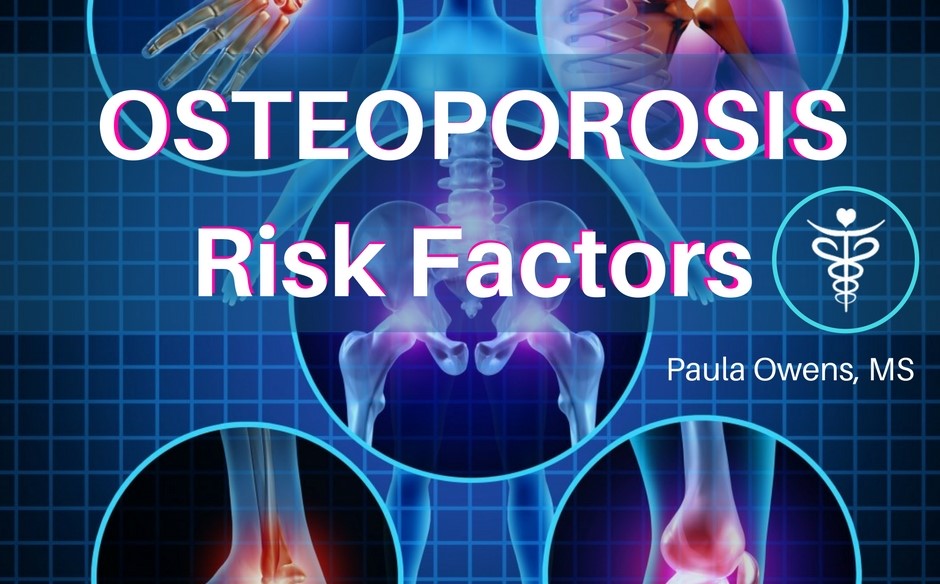Educating and Empowering You to Heal, Thrive, and Live a Happy, Healthy Lifestyle
Osteoporosis Risk Factors
 Osteoporosis is a disease characterized by low bone density and a gradual change in the overall bone structure caused by a deficiency in calcium, vitamin D, magnesium and other vitamins and minerals. Ten million Americans over age 50 have osteoporosis, which leads to a weakening of the skeleton causing fragile, brittle bones. The majority of your body’s peak bone mass is built when you’re a teenager.
Osteoporosis is a disease characterized by low bone density and a gradual change in the overall bone structure caused by a deficiency in calcium, vitamin D, magnesium and other vitamins and minerals. Ten million Americans over age 50 have osteoporosis, which leads to a weakening of the skeleton causing fragile, brittle bones. The majority of your body’s peak bone mass is built when you’re a teenager.
Osteopenia is the thinning of bone mass (decreased bone density) and a risk factor for osteoporosis. Thirty-four million Americans have osteopenia.
Women tend to be afflicted with osteoporosis more often than men, especially postmenopausal women due to hormonal deficiencies particularly estrogen and testosterone. Estrogen, DHEA, cortisol and progesterone are the main hormones that have an impact on bone health. Testosterone, parathyroid hormone, insulin and growth hormone are other hormones that play a role in bone metabolism.
Bone mineral density testing is performed to measure your bone health, diagnose osteoporosis, and help assess the risk of fractures. Low bone mineral density is linked to higher risk of fractures, while normal density is linked to lower risk of fractures. Over a woman’s lifetime, hormonal imbalances, nutrient deficiencies, environmental exposures and other factors can lead to higher bone mineral density, which is also problematic causing an increased risk of breast cancer.
Osteoporosis Risk Factors
Dietary Risk Factors for Osteoporosis
• Extremely low calorie diets, anorexia, bulimia, eating disorders
• Poor dietary choices
• Heavy alcohol consumption
• Lack of protein
• Electrolyte imbalances
• Low salt diets and salt deficiency
• Excessive caffeine intake, which leaches vital minerals from your bones
Lifestyle and Environmental Risk Factors for Osteoporosis
• Medications and drugs (OTC and Rx drugs) that weaken bones and contribute to osteoporosis: Antacids, proton-pump inhibitors (PPIs), antibiotics, steroids, prednisone, cortisone, diuretics, cholesterol-lowering statin drugs, antidepressants, SSRIs, OTC and Rx sleep medications, synthetic thyroid medications (i.e. synthroid), aromatase inhibitors, anticoagulants and some anti-convulsions drugs. Fosamax, has been shown to increase the risk of ulcers and prevent the building of any new bone.
• Oral contraceptives cause bone loss and multiple nutrient deficiencies
• Decrease in weight and/or reduction in height since age 25
• Diseases such as diabetes, rheumatoid arthritis, hyperthyroid, and eating disorders such as bulimia and anorexia accelerate bone loss
• Exposure to phthalates, BPA, glyphosate, toxic chemicals and other endocrine-disrupting chemicals and environmental toxins increase the risk of bone loss
• Early menopause, late menarche, and amenorrhea contribute to bone loss
• Fluoride (destroys collagen) and depletes magnesium and other important minerals. The first city to introduce fluoride into the water supply was Grand Rapids, MI; a 1999 survey indicated Grand Rapids had the highest rate of osteoporosis in the U.S. on a per capita basis.
• Having a small, slender build. Being underweight or low muscle mass.
• Hormone imbalances, including thyroid deficiency
• Insufficient water intake and Dehydration
• Sunlight deficiency. Lack of daily exposure to natural sunlight (vitamin D).
• Elevated homocysteine (>8) increases the risk of bone loss, heart disease, stroke and Alzheimer’s disease. Menopausal women with high homocysteine have double the risk of non-vertebral fractures. [NEJM 2004;350(20):203-2041]
• Insomnia, disrupted circadian rhythms, poor sleep, and long-term sleep deprivation
• Lack of weight-bearing exercise. It’s important to include weight-bearing exercises such as strength training, walking, hiking, yoga and jump rope to keep your bones strong. When you stress your bones with weight-bearing exercises, bone density increases thereby reducing your risk of osteoporosis.
• Liver dysfunction, GI problems, and kidney disorders. Optimal functioning of these organs is required to metabolize vitamin D into its active form.
• Maternal history of hip fractures
• Nutrient deficiencies (specifically, vitamin D, protein, magnesium, boron, calcium, zinc and manganese)
• Hidden infections including Candida overgrowth, fungi, infections in the oral cavity, bacterial infections, parasites, Lyme, mold (mycotoxins)m H. pylori
• Ongoing stress of any form. Stress is regulated by adrenal hormones such as cortisol and DHEA. Studies have proven that high cortisol levels lead to bone loss. Healthy levels of DHEA can prevent bone loss. Massage, exercise, yoga, spending time in nature and meditation are excellent stress relievers that can reduce elevated cortisol thereby reducing risks of bone loss.
• Postmenopausal women who are diabetic are more prone to osteoporosis
• Smoking increases risk of osteoporosis and many other diseases
• Sedentary lifestyles. Sitting all day. Spending less than or equal to four hours per day on feet.
• Heavy metal toxicity. Aluminum toxicity is very common in those with bone loss. It’s important to rule out heavy metal toxicity: lead, cadmium, arsenic, aluminum, iron, tin, mercury and other toxic metals.
Nutrients and Osteoporosis Risk
For years now, the American Heart Association no longer recommends calcium carbonate or calcium citrate supplements such as Caltrate or Citrical for the prevention or treatment of osteoporosis because it has been shown to calcify the coronary arteries and cause kidney stones. This is where vitamin K2 comes in. Many of you have heard of the coronary calcium score that your cardiologists are ordering. The higher the score, the greater your risk is for a heart attack and stroke! Vitamin K2 can protect your small blood vessels from calcification.
• Vitamin D deficiency contributes to breast, prostate and colon cancer, and chronic muscle aches and pains. Foods that are naturally rich in vitamin D are fatty fish like wild salmon, mushrooms, organ meats and egg yolks. More than 50% of females and 35% of males in the U.S. are deficient in vitamin D. Lack of sunshine and the inability to properly digest fats are other factors that contribute a vitamin D deficiency. If you’re taking supplemental vitamin D, it is important to also include vitamin K2 and magnesium.
High Bone Mineral Density and Breast Cancer
Studies show that the risk of breast cancer is greater in postmenopausal women with higher bone mineral density (BMD).
One of the most important facts about bone mineral density is that having higher-than-normal bone density in middle-aged and older women actually INCREASES their risk of breast cancer by 200-300%, and this is according to research published in some of the world’s most well-respected and authoritative journals. (sources below)
High bone density is associated with higher endogenous estrogen levels that is associated with a higher risk of breast cancer. Women in the highest hip bone mineral density (BMD) category are 62% more likely to develop breast cancer than are women in the lowest BMD category.
- Women with bone mineral density above the 25th percentile have 2.0 to 2.5 times increased risk of breast cancer compared with women below the 25th percentile. JAMA; 1996.
- Postmenopausal women in the highest quartile for metacarpal bone mass were found to have an increased risk of developing breast cancer, after adjusting for age and other variables known to influence breast cancer risk. Journal of Nutrition Reviews; 1997.
- Elderly women with high bone mineral density (BMD) have up to 2.7x greater risk of breast cancer (especially advanced cancer) compared with women having lower BMD. J Natl Cancer Inst. 2001.
- Higher bone density (upper 33%) is associated with a 2-fold increased risk of breast cancer. Journal Bone; 2003.
The Good News
There’s plenty you can do to maintain strong, healthy bones, increase bone density and minimize risk of osteopenia and osteoporosis. While some bone loss is a normal part of the aging process, there are many things you can do to Maintain Healthy Bones and Increase Bone Strength.

